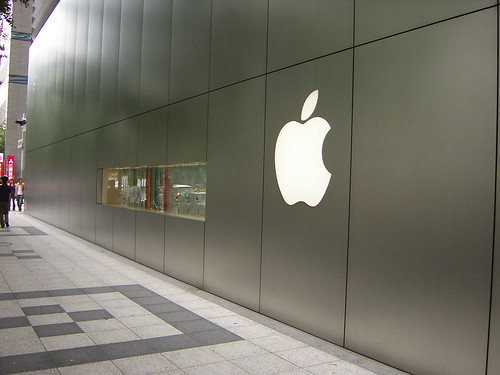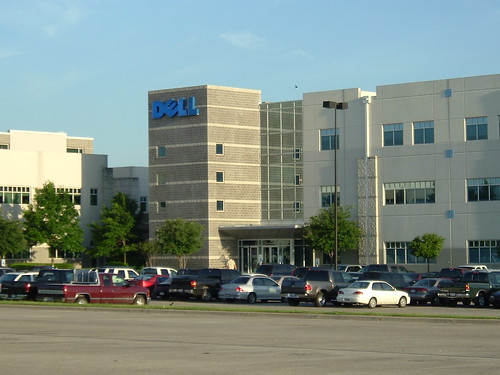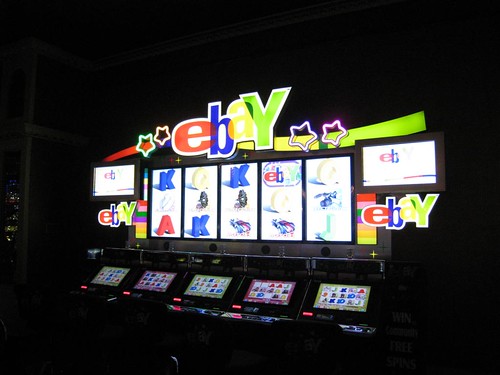Whole Foods Market

In 1978, twenty-five year old college dropout John Mackey and twenty-one year old Rene Lawson Hardy, saved and borrowed money from family and friends to open the doors of a small natural foods store in Austin, Texas. Within a year of opening the store, the couple was evicted from their home for using their apartment storage for the store. Homeless and with no place to go they decided to save costs by moving and living at their store full time. Since their store “Saferway” was zoned for commercial use only, there was no shower stall. According to the company’s website, the two instead bathed in the Hobart dishwasher, which had an attached water hose.
Eventually Mackey and Hardy moved out of the store and into their own place, and within two years managed a merger with another natural foods store to open up the first Whole Foods Market in Austin, Tx on September 20, 1980. With the markets floor space at 10,500 square feet and with 19 employees, Whole Foods Market became the largest of its kind. In 1984, Whole Foods began expanding to other cities by building stores from the ground up and by acquiring other natural foods stores around the country. In 1992 the company went public, and in 2008 posted $6.5 billion in revenues and $3.2 billion in assets. From the humble begginings in Austin, Tx in 1978, to being ranked 369 on the Fortune 500, Whole Foods Market is continually rising to the challenge of the market and providing a unique service to America.
Molson Coors

In 2005, Coors Brewing Company merged with Molson to become the fifth largest brewing company in the world. Though Coors has maintained success throughout the 20th and 21st centuries, the road was long and began with the humble story of a German born immigrant by the name of Adolf Coors. Coors became an orphan at the age of 15 and had to support his younger siblings by working at a local brewery in a small Prussian town, in what is now the modern day city of Wuppertal, Germany. Adolph continued to work in the brewing industry until he was 21, when war and unrest in his country caused him to seek opportunity in America. He then stowed away on a ship, and arrived in the United States in 1868 with no money and no job. From there Coors headed west to look for employment; he found one odd job after another, and supported himself until he would cross paths with another German immigrant in Golden, Co.
Based on Adolf Coors initial investment of $2000 in 1872, his company has grown to be one of the largest brewing companies in the world. Coors’ claim to their success in the brewing business is based on what they refer to as the perfect ingredient: water from the Rocky Mountains. Since day one, Coors Brewing Company has marketed the beer in this way. Today, Coors now has $6.2 billion in revenue and $13.5 billion in assets. Coors Brewing Company is another example of an immigrant success story, where persistence, timing, and smart investments can pay off in the long run.
Apple

Most remember the scene in Forest Gump when he explains that he never has to worry about money again because of his investment in the fruit company called “Apple.” Well the truth is that for many investors this was the case. Like many tech companies, Apple started in the garage of a young man by the name of Steve Wozniack. Wozniack was an electronics hacker, and he and his long time friend Steve Jobs had this idea to create a personal computer. In 1976, the two approached a local electronics store to see if they would be interested in buying a personal computer that Wozniack had built. The owner of the store became interested and said he wanted 50 units. Wozniack and Jobs, both penniless at the time, went to a local computer parts supplier and ordered the parts on credit, based on their first purchase order. This was the start of Apple. Though the company has had its ups and downs in its 30-year history, Apple has proven to be the company that produces the industry standard time and time again. From the garage of Steve Wozniack to being ranked 103 on the Fortune 500, Apple continues to grow and prove to be a wise investment for those looking to expand their portfolios to include “fruit companies.”
Nordstrom

In 1887, a 16-year-old boy form Sweden left his home for the promise of America. He arrived in New York City with only five dollars to his name, and unable to speak a word of English. This boy’s name was John W. Nordstrom. His first years in America were surprisingly tough for the young immigrant; he labored in mines and logging camps just to make survive. Nordstrom however persisted, and took manual labor jobs that allowed him to continually move west towards the Pacific Ocean. After struggling for ten years, the 26-year-old Nordstrom picked up the daily newspaper to find that gold had been discovered in Alaska. As the legend goes, he made plans the very next morning to head north to discover his fortune.
After two years of hard labor, difficult terrain, and relentless competition, Nordstrom experienced moderate success, and was able to save nearly $13,000. He then moved to Seattle, Wa to invest his small fortune. In 1901, Nordstrom opened his first shoe store, just 14 years after coming to America. Throughout the 20th Century Nordstrom grew from the one shoe store in downtown Seattle to what is now a multi-billion dollar retail empire.
Dell

Dell was at one time the largest seller of personal computers and servers in the world. Presently Dell is ranked 34 on the Fortune 500, and in 2008 boasted revenues of $61 Billion with assets toping $27.5 billion. The path to the success that Dell now enjoys began with an idea and a $1,000 investment. While attending the University of Texas in 1984, Michael Dell founded the company as PCs Limited. Initial operations of Dell’s company ran from Dell’s dorm room, until he decided to drop out of college to run his company full time. In 1985, the company produced the first computer of its own design, and by 1988 had an initial public offering that valued the company at nearly $80 million.
Electronic Data Systems

In 1962, former presidential candidate Ross Perot founded EDS with $1000. Perot chose the name Electronic Data Systems from potential names he scribed on the back of a pledge envelope during a church service. Perot had been a salesman for IBM before starting EDS, and he was rejected 77 times before EDS acquired its first client. From processing computer tapes and data from their first client to running the IT arm of hundreds of companies a year after its creation, EDS quickly became the country’s leader in providing IT services to American companies.
By the time EDS went public in October 1968, the market value of EDS would be listed at $378 million. Soon thereafter, EDS expanded its operations globally. Today, EDS is ranked 115 on the Fortune 500, and boast revenues of $22.1 billion and has assets topping $19.2 billion. Perot’s experience was perhaps one of the quickest ascensions to wealth on this list.
Mattel

Shortly after World War II, newly-married Ruth and Elliot Handler decided to start a business out of the garage of their Southern California home. Though Mattel is best known as a toy maker, the brand initially produced and sold picture frames. Shortly after opening for business, Handler began making dollhouse furniture with the scraps left over from the picture frames. The couple would soon find out that the toy business was much more lucrative than picture framing. The Handlers had little business experience and even less capital, but the demographics of a baby boom, plus a virtual toy less marketplace afforded the couple a unique opportunity to carve out a niche. Mattel would have their first hit toy in 1947 with the “Uke-A-Doodle,” a miniature plastic ukulele, that proved to be an immediate success that drew large orders.
By 1955 Mattel had grown enough to become a sponsor of the new television program, “The Micky Mouse Club.” Soon after, Mattel released their iconic toy: Barbie. In 1963 the company went public. From the humble beginnings in the garage to the New York Stock Exchange, Mattel is now ranked 413 on the list of Fortune 500 companies. In 2008, Mattel reached $6 Billion in revenues and reported 4.8 billion in assets.
Wrigley

In the spring of 1891, the 29-year-old William Wrigley Jr. moved from Philadelphia to Chicago with only $32 to his name. Soon after arriving in Chicago, Wrigley began selling soap. As an incentive to the customers, if they purchased his soap, he would give them a free can of baking powder. Soon baking powder proved to be more popular than the soap he was selling, so he switched his business. A year later, in 1892, Wrigley used chewing gum as an incentive for buying his baking powder. Again, chewing gum proved to be more popular than baking powder, and so he switched business again. The first brand of chewing gum Wrigley produced was Juicy Fruit in 1893. Through his personal hard work as a salesman and his ability to advertise, Juicy Fruit would soon become the number 1 selling chewing gum in the country.
Wrigley went public in 1919, and since then has seen ups and downs in the market. Wrigley has remained a staple, and perhaps the most visible brand, in the chewing gum business throughout now into the 21st century. A globally distributed brand, Wrigley is one of the the largest gum company in the world, and one of the most successful businesses – in any industry- in the world. In 2008, Wrigley posted revenues of $5.4 billion with a recorded over $5.2 billion in assets.
Starbucks

In 1971, three academics each invested $1350 of their own money into the first Starbucks located in downtown Seattle. English teacher Jerry Baldwin, history teacher Zev Siegel, and writer Gordon Bowker opened the store called Starbucks Coffee, Tea, and Spice. Shortly after opening, and to continue their operations, the three borrowed another $5000 from the local bank. The three partners wanted to pattern their business after Peet’s Coffee and Tea, in Berkley, Ca, which sold dark roast coffee beans and taught customers how to grind the beans and make freshly brewed coffee at home. It wasn’t until the early 1980’s when Howard Shultz entered the picture that Starbucks began focusing not on selling coffee beans, but on making coffee, tea, and espresso drinks for customers inside the store. Though there was much hesitation from the founding partners, this proved to be the business model Starbucks would follow.
Starbucks went public in 1992, and proved to be one of the most successful IPOs that year. With the infusion of public capitol, Starbucks began to strategically expand all over the US, at one point, at the rate of opening one new store per day. Though Starbucks has seen experienced a decline in popularity in the last several years, the brand’s exponential growth is impressive. In 2008, Starbucks was ranked 277 on the Fortune 500. In the same year Starbucks posted revenues of $9.4 billion and recorded assets of $5.3 billion.
eBay Media

Contrary to popular belief, eBay was not created to find Pez Dispensers for the founder’s wife. This was revealed in Adam Cohen’s 2002 book, The Perfect Store, and confirmed later by eBay. The story was fabricated by a public relations manager in 1997 to interest the media and create a public buzz. Regardless of the legitimacy of the story, media interest and public buzz was created, helping to propel the brand into the minds of consumers (and in this case, would-be merchants and barterers as well). In reality, the first item to ever sell on eBay (then AuctionWeb) was a broken laser pointer, by the French born Iranian immigrant and eBay founder, Pierre Omidyar. The transaction closed in September of 1995, not long after Omidyar finished the code for the website in the living room of his Silicon Valley home.
By June 1996, Omidyar’s website had generated around $10,000 in revenue and Omidyar hired his first employee. Soon after this Omidyar left his day job as a computer programmer. By the end of 1996 the total value of items sold on ebay reached $7.2 million and had over 41,000 registered users. With over 250,000 individual transactions reached in 1996, by 1997 eBay began facilitating over 200,000 transactions a month. This caught the attention of a venture capital group who then invested $5 million in the company. From an idea in an average computer programmers living room in 1995 to being ranked 326 on the list of the Fortune 500 in 2008, eBay is the quintessential American success story.
Source: BusinessPundit.com

No comments:
Post a Comment